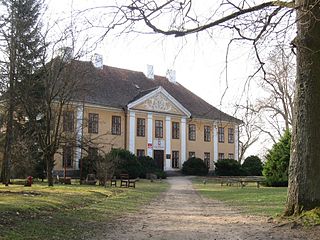
Warmia is both a historical and an ethnographic region in northern Poland, forming part of historical Prussia. Its historic capitals were Frombork and Lidzbark Warmiński and the largest city is Olsztyn.

Ignacy Błażej Franciszek Krasicki, from 1766 Prince-Bishop of Warmia and from 1795 Archbishop of Gniezno, was Poland's leading Enlightenment poet, a critic of the clergy, Poland's La Fontaine, author of the first Polish novel, playwright, journalist, encyclopedist, and translator from French and Greek.

Braniewo, is a town in northern Poland, in Warmia, in the Warmian-Masurian Voivodeship, with a population of 16,907 as of June 2021. It is the capital of Braniewo County.

Royal Prussia or Polish Prussia was a province of the Crown of the Kingdom of Poland, which was established after the Second Peace of Toruń (Thorn) (1466) from territory in Pomerelia and western Prussia which had previously been part of the State of the Teutonic Order. Royal Prussia retained its autonomy, governing itself and maintaining its own laws, customs, rights and German language for German minority.

Warmian–Masurian Voivodeship, also known as Warmia–Masuria Province and Warmia–Mazury Province, is a voivodeship (province) in northeastern Poland. Its capital and largest city is Olsztyn. The voivodeship has an area of 24,192 km2 (9,341 sq mi) and in 2019 had a population of 1,425,967.

Pieniężno is a town in northern Poland, located on the Wałsza River in Warmia, in the Warmian-Masurian Voivodeship. It is located in Braniewo County and had a population of 2,975 in 2004.

Reszel is a town in the Warmian-Masurian Voivodeship, in northeastern Poland. As of 2012 the population was 4,896. A small medieval town situated in the historical Warmia region, Reszel possesses many architecturally-renowned monuments and various attractions. The Gothic castle, the main square and the core surrounded by brick defense walls are very popular among incoming tourists.

Warmians were a Prussian tribe that lived in Warmia, a territory which now mostly forms part of the Warmian-Masurian Voivodeship in Poland, with a small northern portion located in neighbouring Russia. It was situated between the Vistula Lagoon, Łyna and Pasłęka Rivers.
Nicolaus von Tüngen was bishop of Warmia from 1467 until 1489.

Tolkmicko is a town in northern Poland, on the Vistula Lagoon, about 20 km northeast of Elbląg. It is located in Warmian-Masurian Voivodeship, in Elbląg County. Its population is 2,766 (2004).

Mauritius Ferber was a member of the patrician Ferber family. As Roman Catholic Prince-Bishop of Warmia (Ermland), he prevented most towns in his diocese from converting to Protestantism while the surrounding hitherto Catholic State of the Teutonic Order was transformed into the Duchy of Prussia and became the first state to adopt Lutheranism.
Mikołaj Szyszkowski (1590–1643) of Clan Ostoja was a Prince-bishop of Warmia from 1633 until his death in 1643.

The Archdiocese of Warmia is a Latin Church Metropolitan archdiocese of the Catholic Church in the Warmian-Masurian Voivodeship, Poland.

Smolajny is a village in the administrative district of Gmina Dobre Miasto, within Olsztyn County, Warmian-Masurian Voivodeship, in northern Poland. It lies on the Łyna River in the historical region of Warmia, approximately 5 kilometres (3 mi) north of Dobre Miasto and 28 km (17 mi) north of the regional capital Olsztyn.

Adam Stanisław Grabowski, of the Zbiświcz coat-of-arms, was Bishop of Chełmno 1736–39, Bishop of Kujawy 1739–41, Prince-Bishop of Warmia 1741–66.

Jonkowo is a village in Olsztyn County, Warmian-Masurian Voivodeship, in northern Poland. It is the seat of the gmina called Gmina Jonkowo. It lies approximately 14 km (9 mi) west of the regional capital Olsztyn. It is located in Warmia.

The Prince-Bishopric of Warmia was a semi-independent ecclesiastical state, ruled by the incumbent ordinary of the Warmia see and comprising one third of the then diocesan area. The Warmia see was a Prussian diocese under the jurisdiction of the Archbishopric of Riga that was a protectorate of the Monastic state of the Teutonic Knights (1243–1464) and a protectorate and part of the Kingdom of Poland—later part of the Polish–Lithuanian Commonwealth (1464–1772), confirmed by the Peace of Thorn in 1466. The other two thirds of the diocese were under the secular rule of the Teutonic Knights until 1525 and Ducal Prussia thereafter, both entities also being a protectorate and part of Poland from 1466.

The Lidzbark Castle, officially known as Lidzbark Bishops' Castle, is a fortified castle and palace from the 14th century located in the town of Lidzbark Warmiński, Warmian-Masurian Voivodeship, in northern Poland. It is one of the most precious Gothic structures in the country and a popular destination for holidaymakers.

The Olsztyn Castle, officially the Castle of Warmian Cathedral Chapter in Olsztyn, is a Brick Gothic castle located in the heart of Olsztyn, in northern Poland. Built in the 14th century, it served as the seat for administrators of property of the Warmian Cathedral Chapter. The most well-known administrator caretaker was Nicolaus Copernicus, a canon of Warmian Cathedral Chapter in Frombork, who resided here between 1516 and 1521. The largest expository room is the refectory with a diamond vault built around 1520. Currently, the castle houses the Museum of the Warmian-Masurian Voivodeship.





























